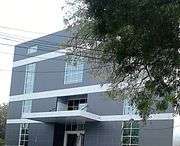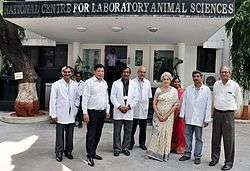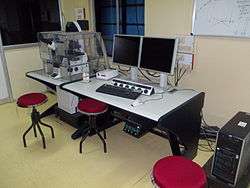National Institute of Nutrition, Hyderabad
 | |
| Motto | "To achieve optimal nutrition of vulnerable segments of population such as women of reproductive age, children, adolescent girls and elderly by 2020" |
|---|---|
| Established |
1918 (Coonoor) 1958 (Hyderabad, Telangana, India) |
| Research type | Public |
Field of research |
Nutrition Micronutrients |
| Director | Thingnganing Longvah[1] |
| Address | Jamai-Osmania |
| Location | Hyderabad, India |
| Campus | Urban, Tarnaka |
| Affiliations | Dr. N.T.R. University of Health Sciences |
Operating agency | ICMR |
| Website |
ninindia |
The National Institute of Nutrition (NIN) is an Indian Public health, Biotechnology and Translational research center located in Hyderabad, India.[2][3] The institute is one of the oldest research centers in India, and the largest center, under the Indian Council of Medical Research, located in the vicinity of Osmania University. The institute has associated clinical and pediatric nutrition research wards at various hospitals such as the Niloufer Hospital for Women and Children, the Government Maternity Hospital, the Gandhi Medical College and the Osmania General Hospital in Hyderabad.
The National Centre for Laboratory Animal Science (to be integrated into the National Animal Resource Facility for Biomedical Research), and the Food & Drug Toxicology Research Centre, National Nutrition Monitoring Bureau are the other wings of NIN,[4] for India's Ministry of Health and Family Welfare.[5] The institute also derives funding from the Indian Department of Biotechnology. The institute majorly conducts research in obesity, diabetes, food chemistry, dietetics, drug toxicology, and micronutrient deficiency [6][7] in collaboration with centers such as the Rockefeller University, University of Colorado School of Medicine, Washington University, and the Johns Hopkins Bloomberg School of Public Health in the U.S..[8][9][10] and the University of Wollongong in Australia.[11][12]
History


The Institute was founded in 1918 by Sir Robert McCarrison. It was originally a single room laboratory at the Pasteur Institute, Coonoor, Tamil Nadu for the study of Beriberi, and was called the Beri-Beri Enquiry Unit.[13] McCarrison was invalided to Britain from 1920–1922, and in 1923 the enquiry was axed on financial grounds. It was restored two years later as the Deficiency Disease Inquiry, which McCarrison headed from 1925-1929.[14] The scope of the laboratory expanded to include all deficiency diseases, and around 1928-29 became the Nutrition Research Laboratories (NRL), with McCarrison as its first Director, until his retirement in 1935, when he was succeeded by Dr. W.R. Ackroyd.[13][14][15] The facility moved to Hyderabad in 1958 and in 1969 was renamed the National Institute of Nutrition.[13]
Research






The institute carries out research and patent development in clinical nutrition, outcomes research, pharmacology,[16] pathology, toxicology, food chemistry,[17] endocrinology,[7] molecular biology,[18] regenerative medicine,[19][20] community nutrition,[21][22] ophthalmology,
[23] and sports nutrition.[24][25] Agencies such as WHO and FAO recognized the institute as a Centre for excellence in food quality, safety and nutrition research.[26][27][28][29][30]
The institute is equipped with state of the art facilities among Animal housing, In vivo-imaging, Automated electrophoresis, Flow cytometry, DNA Microarray, Liquid chromatography–mass spectrometry, Atomic absorption spectroscopy, Matrix-assisted laser desorption/ionization, Scanning electron microscope, Confocal laser scanning microscopy, Transmission electron microscopy, DNA sequencers, Cryogenic equipment, thermal cyclers etc.[31][32][33]
National Center for Laboratory Animal Sciences (NCLAS)
Developed obese and diabetic mutant rat models: WNIN/GR-Ob, WNIN/Ob, WNIN/Ob-IGT, to serve as pre-clinical animal models in drug development for chronic diseases like diabesity. Established a state of the art non-human primate facility with provision for experiments based on monkeys.[34][35] NCLAS also came into the limelight due to the WNIN/Ob obese rat strain which is the heaviest inbred rat model available.[36] It has been reported to reach up to 1.47 kg in body weight [37] and shows various signs of increased DNA damage and significantly decreased lifespan.[38]
NIN and FSSAI
The Food Safety and Standards Authority of India (FSSAI), co-chaired by the Director of NIN [39] is an agency of the Ministry of Health & Family Welfare, Government of India.[40] The FSSAI is responsible for protecting and promoting public health through the regulation and supervision of food safety.[40] The FSSAI has been established under the Food Safety and Standards Act, 2006 which is a consolidating statute related to food safety and regulation in India.[40]
Education
NIN offers advanced education courses and MS-MD-PhD program(s) for nutrition, biochemistry, dietetics and laboratory animal sciences. The Centre is recognized by Dr. N.T.R. University of Health Sciences for pursuing post graduation in Applied Nutrition. Recently NIN has started awarding Research Fellowships to the toppers in the M.Sc. course to pursue Ph.D. in the institution. The institute is well recognized by Osmania University, University of Hyderabad, Jawaharlal Nehru Technological University, for pursuing Ph.D. in various streams of Life Sciences especially Biochemistry and Nutrition. The institute has trained over 1600 health professionals from more than 35 countries. More than 150 candidates have successfully obtained Ph.D. and MD degrees from NIN.
Achievements
- Assessed dietary intake of individuals, house holds and nutritional profiles of different communities through periodic surveys of NNMB in 10 states.
- Suggested strategies to identify high risk pregnancies in rural areas of India. These were included in the National Reproductive and Child Health Program.
- Demonstrated TheraCyte Pancreatic Islet Transplantation technology in Primates and Rodents.
- Commercially delivered double fortified Salt - Tata Salt Plus, priced at an economical rate of Rs 20 per kg, is an iodine plus iron fortified salt, developed by double fortification technology. This technology was offered to Tata Chemicals under a long-term MoU after due studies on bio-availability across the population strata conducted and published by NIN.[41]
- Exploded the protein myth and highlighted calorie gap as the major bottleneck for healthy growth of childrem.
- Developed simple and sensitive biochemical indicators for assessment of vitamin nutritive and pathogenic mechanisms of various nutritional deficiency syndromes.
- Established growth norms for Indian children.
- Emphasized the importance of growth monitoring for early diagnosis and appropriate management of protein energy malnutrition.
- Generated database on nutritive values of over 650 Indian foods, which is used by various national organizations, planners and academic research institutions
- Formulated Recommended Dietary Allowances (RDA) for Indians.
- Developed food based Dietary Guidelines for Indians.
- Developed National Nutrition Surveillance system (NSS-Triple A cycle of Assessment, Analysis and Action) to serve as an early warning system about nutrition problems.
See also
- Genome Valley
- National Animal Resource Facility for Biomedical Research
- Central Drugs Standard Control Organization
References
- ↑ "Thingnganing Longvah". ResearchGate.
- ↑ Bhargava, Pushpa M (12 November 2011). "Could they buy salt and spices, fuel and milk, and pay rent... with Rs. 2.33 a day?". The Hindu. Chennai, India.
- ↑ "International Conference on Translational Research" (PDF). Retrieved 2012-08-21.
- ↑ About ICMR, Indian Council of Medical Research, retrieved 15 August 2010 ICMR's Institutes/Centres (scroll down page to find NIN)
- ↑ Special Correspondent (2012-10-11). "NATIONAL / ANDHRA PRADESH : Governor for review of PDS". Chennai, India: The Hindu. Retrieved 2012-12-07.
- ↑ Venu, L; Harishankar, N; Krishna, T. P.; Raghunath, M (2004). "Does maternal dietary mineral restriction per se predispose the offspring to insulin resistance?". European journal of endocrinology / European Federation of Endocrine Societies. 151 (2): 287–94. PMID 15296486. doi:10.1530/eje.0.1510287.
- 1 2 Ghosh S, Sinha JK, Putcha UK, Raghunath M (2016). "Severe but Not Moderate Vitamin B12 Deficiency Impairs Lipid Profile, Induces Adiposity, and Leads to Adverse Gestational Outcome in Female C57BL/6 Mice". Frontiers in Nutrition. 3 (1): 1–10. PMC 4722109
 . PMID 26835453. doi:10.3389/fnut.2016.00001.
. PMID 26835453. doi:10.3389/fnut.2016.00001. - ↑ Fernandez-Rao, Sylvia; Hurley, Kristen M.; Nair, Krishnapillai Madhavan; Balakrishna, Nagalla; Radhakrishna, Kankipati V.; Ravinder, Punjal; Tilton, Nicholas; Harding, Kimberly B.; Reinhart, Greg A.; Black, Maureen M. (2014). "Integrating nutrition and early child-development interventions among infants and preschoolers in rural India". wiley.com. 1308: 218–231. Bibcode:2014NYASA1308..218F. doi:10.1111/nyas.12278.
- ↑ "National conference on nutrition security at NIN, Hyderabad - The Times of India". The Times Of India.
- ↑ "Mice to reveal key to human obesity - The Times of India". The Times Of India.
- ↑ "Australia-India food research partnerships on the menu - News & Media @ UOW". Media.uow.edu.au. 2008-03-27. Retrieved 2012-09-01.
- ↑ "Director in charge of NIN". Retrieved 2012-09-03.
- 1 2 3 Down the memory lane, National Institute of Nutrition, Hyderabad, India, retrieved 12 August 2010
- 1 2 Arnold, David (2000), Science, technology, and medicine in Colonial India, The New Cambridge History of India. Part III, Volume 5, Cambridge, UK: Cambridge University Press, pp. 201, 215, ISBN 0-521-56319-4, retrieved 12 August 2010
- ↑ NIN origins (May 28, 1960), "Obituary: Sir ROBERT McCARRISON, C.I.E., M.D., D.Sc. L.L.D., F.R.C.P", British Medical Journal, 1 (5186): 1663–1664, PMC 1967996
 , PMID 13856887, doi:10.1136/bmj.1.5186.1663, retrieved 10 August 2010
, PMID 13856887, doi:10.1136/bmj.1.5186.1663, retrieved 10 August 2010 - ↑ "Pyridoxal 5′ phosphate protects islets against streptozotocin-induced beta-cell dysfunction – in vitro and in vivo". Ebm.rsmjournals.com. 2011-04-04. Retrieved 2012-08-30.
- ↑ https://www.researchgate.net/institution/Indian_Council_of_Medical_Research/department/Division_of_Food_Chemistry
- ↑ Dutta, R. C. (2012-05-24). "In search of optimal scaffold for regenerative medicine and therapeutic delivery". Ther Deliv. 2 (2): 231–4. PMID 22833949. doi:10.4155/tde.10.100.
- ↑ Rajarathna (2010). "advancements in stem cell research: an Indian perspective-II | T". Annals of neurosciences. Annals of Neurosciences. 17 (3). doi:10.5214/ans.0972-7531.1017303. Retrieved 2012-08-30.
- ↑ Tissue and Cell, v.43, no.4, 2011 August, p.266(5) (ISSN 0040-8166)
- ↑ "Hyderabad to host national meet on diet". The Times Of India. 11 April 2012.
- ↑ "Landes Bioscience Journals: Islets". Landesbioscience.com. Retrieved 2012-08-21.
- ↑ "A novel mutation (F71L) in αA-Crystallin with defective chaperone-like function associated with age-related cataract". ResearchGate. Retrieved 2012-09-01.
- ↑ "Nutrition and Hydration guidelines for excellence in sports" (PDF). Retrieved 2012-08-21.
- ↑ "Nagaland News | Current News | Latest News | Breaking News - India: Olympic Medals?". The Morung Express. Retrieved 2012-08-21.
- ↑ "NIN introduces indigenous developed cost effective pathogen detection kit". Pharmabiz.com. Retrieved 2012-08-21.
- ↑ "NIN bags ‘City Strategist' award". The Hindu. Chennai, India. 26 April 2010.
- ↑ "National Institute of Nutrition develops food contamination detection kits". Times Of India. 2012-04-27. Retrieved 2012-08-21.
- ↑ "Leadership in Nutrition" (PDF). Retrieved 2012-08-21.
- ↑ Patent file No.IPD/PA/96022/97 Microbiological Identification kit.
- ↑ "National Institute of Nutrition Hyderabad". Icmr.nic.in. Retrieved 2012-08-21.
- ↑ "Annual Report 2012" (PDF). Retrieved 2012-08-21.
- ↑ "Analysis of Reproductive Health, ICMR" (PDF). Retrieved 2012-08-21.
- ↑ "Annual Report 2012" (PDF). Retrieved 2012-08-21.
- ↑ "Analysis of Reproductive Health, ICMR" (PDF). Retrieved 2012-08-21.
- ↑ K. S. Jayaraman (2005). "'Sumo' rats set researchers on hunt for obesity genes". Nature Medicine. 11 (2): 108. PMID 15692582. doi:10.1038/nm0205-108a.
- ↑ Sinha, Jitendra Kumar; Giridharan, Nappan Veethil; Raghunath, Manchala (2012). "Can systemic and central IGF1 and BDNF levels play a role in decreasing the longevity of WNIN obese mutant rats?". International Journal of Developmental Neuroscience. 30 (8): 648–49. doi:10.1016/j.ijdevneu.2012.03.253.
- ↑ Sinha, Jitendra Kumar; Ghosh, Shampa; Swain, Umakanta; Giridharan, Nappan Veethil; Raghunath, Manchala (2014). "Increased macromolecular damage due to oxidative stress in the neocortex and hippocampus of WNIN/Ob, a novel rat model of premature aging". Neuroscience. 269: 256–64. PMID 24709042. doi:10.1016/j.neuroscience.2014.03.040.
- ↑ "New provisions for packaged food labelling soon". The Times Of India. 2 April 2012.
- 1 2 3 "Food Safety and Standards Authority of India (FSSAI)". Food Safety and Standards Authority of India, Government of India. Retrieved 2 April 2012.
- ↑ "Tata group - Tata Chemicals - Media releases - India’s first iodine plus iron fortified salt launched by Tata Chemicals". tata.com.
External links
| Wikimedia Commons has media related to National Institute of Nutrition, Hyderabad. |
- Homepage of National Institute of Nutrition, Hyderabad, India
- Library of the National Institute of Nutrition (Indian Council of Medical Research) Hyderabad (India)
- NIN Annual Report 2005-2006